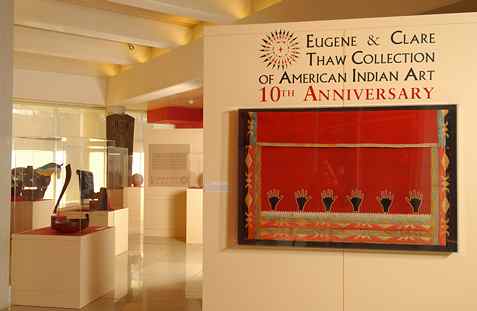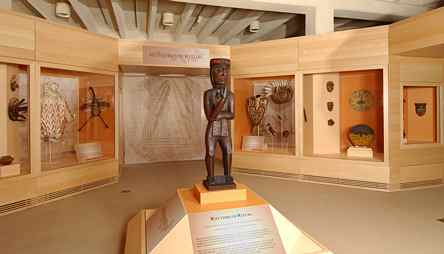
Editor's note: The Fenimore Art Museum provided source material to Resource Library for the following article or essay. If you have questions or comments regarding the source material, please contact the Fenimore Art Museum directly through either this phone number or web address:
The Eugene and Clare Thaw Collection of American Indian Art
The Eugene and
Clare Thaw Collection of American Indian Art showcases
more than 50 new acquisitions in the 10th Anniversary exhibit, on
view through December 31, 2005, at the Fenimore Art Museum. This renowned
collection, comprising more than 800 objects, is located in the American
Indian Wing, an 18,000-square-foot addition completed in 1995. 
"This exhibit celebrates the Thaw's commitment to the beauty and artistry of American Indian art and showcases extraordinary objects that illustrate the vitality and richness of this art," said Paul D'Ambrosio, Chief Curator, Fenimore Art Museum. "With this nationally recognized collection, Fenimore Art Museum has become one of America's premier art museums, attracting diverse audiences including noted scholars and researchers," D'Ambrosio added. (right: Gallery view from an exhibition of The Eugene and Clare Thaw Collection of American Indian Art. Photo by Richard Walker)
The exhibition is displayed in four themes: Celebrating Beauty, Completing the Portrait, Discovering History, and Living Traditions.
Among the new acquisitions celebrating the aesthetic quality of the objects is a wooden feast bowl made by the Iroquois circa 1780 with two finely carved spirit effigies. Their distinct features distinguish them as a male and a female. Images of women appear on Great Lakes love dolls and medicine dolls but carved images of women on other Woodlands art are rare. A very rare Nootka float basket from Vancouver Island, made around 1910 is another outstanding addition. A Nootka weaver covered this float used by Japanese fisherman with woven basketry, depicting major symbols of the culture. Most prominent is the Thunderbird, a supernatural being that hunts whales.
Several new additions under the Completing the Portrait theme broaden our understanding of American Indian art including an Osage woman's wearing blanket and a Tahltan man's firebag. The Osage people were located on a reservation in northeastern Oklahoma in 1869. When oil was discovered on their land in the 1890s, they soon acquired wealth to enhance their traditional material culture. This wool blanket has been transformed into a beautifully patterned wearing blanket with silk ribbon appliqué. In the early 1900s firebags were an important part of ceremonial dress, and featured bold designs on vivid red cloth. The geometric designs on the strap of this bag were inspired by the work of neighboring Tlingit basketmakers. Tahltan women adorned the firebags with dentalium, a highly prized white horn-shaped shell traded by the people of Vancouver Island.
One of the guiding principles in developing the collection
is the acquisition of works by known artists, or works with a documented
history of ownership. Recently acquired works illustrating the Discovering
History theme include those by such distinguished artists as Charles Edenshaw,
Salena Jackson and Nampeyo. A jar and bowl made by Nampeyo, illustrates
in form and design, the artistic tradition defined by the pottery type known
as Sikyatki Polychrome (A.D. 1375-1625). These objects display a perfection
of form and incorporate abstract designs, geometric patterns and anthropomorphic
motifs.
The exhibit also showcases the work of contemporary artists including G. Peter Jemison, Stan Hill, and Dyanne Strongbow. These artists employ traditional methods and designs while incorporating new themes to create reinterpretations of ancient expressions. Dried Geometry by G. Peter Jemison, a professionally trained artist, honors ancient Iroquois gardening traditions that focus upon the three sisters: corn, squash and beans. Jemison was inspired by gardens at Ganondagan, a 17th-century Seneca village that is now an historic site. Choctaw artist Dyanne Strongbow continues the tradition of paying honor to the horse with her sculpture Lightning Bolt Colt, one of 250 included in Santa Fe's Painted Ponies art event in 2001. (right: Gallery view from an exhibition of The Eugene and Clare Thaw Collection of American Indian Art. Photo by Richard Walker)
A full-color catalog highlighting gifts to the Thaw Collection from 2000 to the present will be published in June, 2005.
About the Eugene & Clare Thaw Collection of American Indian Art
Fenimore Art Museum drew considerable attention in the art world in 1993 with the announcement that Eugene and Clare Thaw promised the museum their collection of North American Indian art. The Thaw Collection contains numerous masterpieces and is one of the finest private collections amassed in recent years. With this addition, the range of American art at the museum increased dramatically to include artistic achievements on the North American continent from 200 B.C. to the present.
The Thaws began collecting North American Indian art in 1987. They initially started with an interest in Indian art that incorporated the image of the American flag, but soon focused upon the larger goal of acquiring a comprehensive collection. With a background in European art, the Thaws drew upon their past experience and acquired Indian objects as art, not as anthropological specimens. Their interest was and remains aesthetic quality. Today, this acclaimed collection now numbers over 800 objects and continues to grow with the addition of exceptional pieces that enrich our understanding of North American Indian art.
Lecture series
In celebration of the 10th Anniversary of the Eugene and Clare Thaw Collection of American Indian Art, Fenimore Art Museum will host noted American Indian artists and scholars for an afternoon-long lecture series entitled "Creation and Scholarship in Native American Art: The Past in the Present" on June 18 from 1 to 5 pm.
Topics relating to Native American art and culture, such as Iroquois beadwork, Central Yup'ik masks, and Native American art history will be discussed by guest speakers Jolene Rickard, Associate Professor of Art History and Studio Art, SUNY-Buffalo; Janet Berlo, Co-Director of the Graduate Program in Visual and Cultural Studies at the University of Rochester; Bill McLennan, curator at the Museum of Anthropology at the University of British Columbia; Lyle Wilson, Haisla artist who has worked as a carver, graphic artist and glass worker; Sam Thomas, a well-known Iroquois bead worker who has worked in the field for over 20 years; and Chuna McIntyre, an artist, historian and storyteller.
Schedule:
Lectures are open to the general public and included with museum admission. The lecture series was organized in cooperation with The Otsego Institute, a professional development workshop that draws young professionals and distinguished faculty members from the disciplines of art history, ethno history, and archaeology from around the world to explore key issues and methods for the study of Native North American art history. For reservations or more information on the lecture series, contact Fenimore Art Museum at (607) 547-1400 or toll-free at (888) 547-1450.
rev. 6/10/05
Read more articles and essays concerning this institutional source by visiting the sub-index page for the Fenimore Art Museum in Resource Library.
Visit the Table of Contents for Resource Library for thousands of articles and essays on American art.
© Copyright 2005 Traditional Fine Arts Organization, Inc., an Arizona nonprofit corporation. All rights reserved.